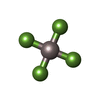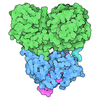[English] 日本語
 Yorodumi
Yorodumi- PDB-8wa5: Cryo-EM structure of the gastric proton pump Y799W/E936Q mutant i... -
+ Open data
Open data
- Basic information
Basic information
| Entry | Database: PDB / ID: 8wa5 | ||||||
|---|---|---|---|---|---|---|---|
| Title | Cryo-EM structure of the gastric proton pump Y799W/E936Q mutant in K+-occluded (K+)E2-AlF state | ||||||
 Components Components |
| ||||||
 Keywords Keywords |  MEMBRANE PROTEIN / MEMBRANE PROTEIN /  P-type ATPase / gastric proton pump / primary transporter / P-type ATPase / gastric proton pump / primary transporter /  transporter transporter | ||||||
| Function / homology |  Function and homology information Function and homology information regulation of proton transport / pH reduction / potassium:proton exchanging ATPase complex / P-type potassium:proton transporter activity / Ion transport by P-type ATPases / P-type sodium:potassium-exchanging transporter activity / sodium:potassium-exchanging ATPase complex / sodium ion export across plasma membrane / intracellular potassium ion homeostasis / intracellular sodium ion homeostasis ... regulation of proton transport / pH reduction / potassium:proton exchanging ATPase complex / P-type potassium:proton transporter activity / Ion transport by P-type ATPases / P-type sodium:potassium-exchanging transporter activity / sodium:potassium-exchanging ATPase complex / sodium ion export across plasma membrane / intracellular potassium ion homeostasis / intracellular sodium ion homeostasis ... regulation of proton transport / pH reduction / potassium:proton exchanging ATPase complex / P-type potassium:proton transporter activity / Ion transport by P-type ATPases / P-type sodium:potassium-exchanging transporter activity / sodium:potassium-exchanging ATPase complex / sodium ion export across plasma membrane / intracellular potassium ion homeostasis / intracellular sodium ion homeostasis / potassium ion import across plasma membrane / ATPase activator activity / potassium ion transmembrane transport / proton transmembrane transport / regulation of proton transport / pH reduction / potassium:proton exchanging ATPase complex / P-type potassium:proton transporter activity / Ion transport by P-type ATPases / P-type sodium:potassium-exchanging transporter activity / sodium:potassium-exchanging ATPase complex / sodium ion export across plasma membrane / intracellular potassium ion homeostasis / intracellular sodium ion homeostasis / potassium ion import across plasma membrane / ATPase activator activity / potassium ion transmembrane transport / proton transmembrane transport /  cell adhesion / response to xenobiotic stimulus / apical plasma membrane / magnesium ion binding / cell adhesion / response to xenobiotic stimulus / apical plasma membrane / magnesium ion binding /  ATP hydrolysis activity / ATP hydrolysis activity /  ATP binding ATP bindingSimilarity search - Function | ||||||
| Biological species |   Sus scrofa (pig) Sus scrofa (pig) | ||||||
| Method |  ELECTRON MICROSCOPY / ELECTRON MICROSCOPY /  single particle reconstruction / single particle reconstruction /  cryo EM / Resolution: 2.51 Å cryo EM / Resolution: 2.51 Å | ||||||
 Authors Authors | Abe, K. | ||||||
| Funding support |  Japan, 1items Japan, 1items
| ||||||
 Citation Citation |  Journal: J Biol Chem / Year: 2024 Journal: J Biol Chem / Year: 2024Title: Specific protonation of acidic residues confers K selectivity to the gastric proton pump. Authors: Hridya Valia Madapally / Kazuhiro Abe / Vikas Dubey / Himanshu Khandelia /   Abstract: The gastric proton pump (H,K-ATPase) transports a proton into the stomach lumen for every K ion exchanged in the opposite direction. In the lumen-facing state of the pump (E2), the pump selectively ...The gastric proton pump (H,K-ATPase) transports a proton into the stomach lumen for every K ion exchanged in the opposite direction. In the lumen-facing state of the pump (E2), the pump selectively binds K despite the presence of a 10-fold higher concentration of Na. The molecular basis for the ion selectivity of the pump is unknown. Using molecular dynamics simulations, free energy calculations, and Na and K-dependent ATPase activity assays, we demonstrate that the K selectivity of the pump depends upon the simultaneous protonation of the acidic residues E343 and E795 in the ion-binding site. We also show that when E936 is protonated, the pump becomes Na sensitive. The protonation-mimetic mutant E936Q exhibits weak Na-activated ATPase activity. A 2.5-Å resolution cryo-EM structure of the E936Q mutant in the K-occluded E2-Pi form shows, however, no significant structural difference compared with wildtype except less-than-ideal coordination of K in the mutant. The selectivity toward a specific ion correlates with a more rigid and less fluctuating ion-binding site. Despite being exposed to a pH of 1, the fundamental principle driving the K ion selectivity of H,K-ATPase is similar to that of Na,K-ATPase: the ionization states of the acidic residues in the ion-binding sites determine ion selectivity. Unlike the Na,K-ATPase, however, protonation of an ion-binding glutamate residue (E936) confers Na sensitivity. | ||||||
| History |
|
- Structure visualization
Structure visualization
| Structure viewer | Molecule:  Molmil Molmil Jmol/JSmol Jmol/JSmol |
|---|
- Downloads & links
Downloads & links
- Download
Download
| PDBx/mmCIF format |  8wa5.cif.gz 8wa5.cif.gz | 360.4 KB | Display |  PDBx/mmCIF format PDBx/mmCIF format |
|---|---|---|---|---|
| PDB format |  pdb8wa5.ent.gz pdb8wa5.ent.gz | 238.5 KB | Display |  PDB format PDB format |
| PDBx/mmJSON format |  8wa5.json.gz 8wa5.json.gz | Tree view |  PDBx/mmJSON format PDBx/mmJSON format | |
| Others |  Other downloads Other downloads |
-Validation report
| Arichive directory |  https://data.pdbj.org/pub/pdb/validation_reports/wa/8wa5 https://data.pdbj.org/pub/pdb/validation_reports/wa/8wa5 ftp://data.pdbj.org/pub/pdb/validation_reports/wa/8wa5 ftp://data.pdbj.org/pub/pdb/validation_reports/wa/8wa5 | HTTPS FTP |
|---|
-Related structure data
| Related structure data |  37391MC M: map data used to model this data C: citing same article ( |
|---|---|
| Similar structure data | Similarity search - Function & homology  F&H Search F&H Search |
- Links
Links
- Assembly
Assembly
| Deposited unit | 
|
|---|---|
| 1 |
|
- Components
Components
-Protein , 2 types, 2 molecules AB
| #1: Protein | Mass: 114282.594 Da / Num. of mol.: 1 / Mutation: Y799W/E936Q Source method: isolated from a genetically manipulated source Source: (gene. exp.)   Sus scrofa (pig) / Gene: ATP4A / Production host: Sus scrofa (pig) / Gene: ATP4A / Production host:   Homo sapiens (human) / References: UniProt: F1RM59 Homo sapiens (human) / References: UniProt: F1RM59 |
|---|---|
| #2: Protein | Mass: 33113.844 Da / Num. of mol.: 1 Source method: isolated from a genetically manipulated source Source: (gene. exp.)   Sus scrofa (pig) / Gene: ATP4B / Production host: Sus scrofa (pig) / Gene: ATP4B / Production host:   Homo sapiens (human) / References: UniProt: P18434 Homo sapiens (human) / References: UniProt: P18434 |
-Sugars , 1 types, 5 molecules 
| #8: Sugar | ChemComp-NAG /  N-Acetylglucosamine N-Acetylglucosamine |
|---|
-Non-polymers , 6 types, 13 molecules 










| #3: Chemical | | #4: Chemical | ChemComp-ALF / | #5: Chemical | ChemComp-MG / | #6: Chemical | ChemComp-CLR / |  Cholesterol Cholesterol#7: Chemical | ChemComp-PCW / | #9: Water | ChemComp-HOH / |  Water Water |
|---|
-Details
| Has ligand of interest | Y |
|---|
-Experimental details
-Experiment
| Experiment | Method:  ELECTRON MICROSCOPY ELECTRON MICROSCOPY |
|---|---|
| EM experiment | Aggregation state: PARTICLE / 3D reconstruction method:  single particle reconstruction single particle reconstruction |
- Sample preparation
Sample preparation
| Component | Name: alpha-beta complex of the gastric proton pump / Type: COMPLEX / Entity ID: #1-#2 / Source: RECOMBINANT |
|---|---|
| Molecular weight | Value: 0.135 MDa / Experimental value: YES |
| Source (natural) | Organism:   Sus scrofa (pig) Sus scrofa (pig) |
| Source (recombinant) | Organism:   Homo sapiens (human) Homo sapiens (human) |
| Buffer solution | pH: 6.5 |
| Specimen | Embedding applied: NO / Shadowing applied: NO / Staining applied : NO / Vitrification applied : NO / Vitrification applied : YES : YES |
Vitrification | Cryogen name: ETHANE |
- Electron microscopy imaging
Electron microscopy imaging
| Experimental equipment |  Model: Titan Krios / Image courtesy: FEI Company |
|---|---|
| Microscopy | Model: FEI TITAN KRIOS |
| Electron gun | Electron source : :  FIELD EMISSION GUN / Accelerating voltage: 300 kV / Illumination mode: FLOOD BEAM FIELD EMISSION GUN / Accelerating voltage: 300 kV / Illumination mode: FLOOD BEAM |
| Electron lens | Mode: BRIGHT FIELD Bright-field microscopy / Nominal defocus max: 1600 nm / Nominal defocus min: 800 nm Bright-field microscopy / Nominal defocus max: 1600 nm / Nominal defocus min: 800 nm |
| Image recording | Electron dose: 64 e/Å2 / Film or detector model: GATAN K3 (6k x 4k) |
- Processing
Processing
CTF correction | Type: PHASE FLIPPING AND AMPLITUDE CORRECTION | ||||||||||||||||||||||||
|---|---|---|---|---|---|---|---|---|---|---|---|---|---|---|---|---|---|---|---|---|---|---|---|---|---|
3D reconstruction | Resolution: 2.51 Å / Resolution method: FSC 0.143 CUT-OFF / Num. of particles: 302608 / Symmetry type: POINT | ||||||||||||||||||||||||
| Refinement | Cross valid method: NONE Stereochemistry target values: GeoStd + Monomer Library + CDL v1.2 | ||||||||||||||||||||||||
| Displacement parameters | Biso mean: 54.08 Å2 | ||||||||||||||||||||||||
| Refine LS restraints |
|
 Movie
Movie Controller
Controller


 PDBj
PDBj




















